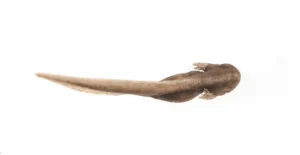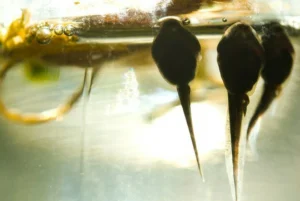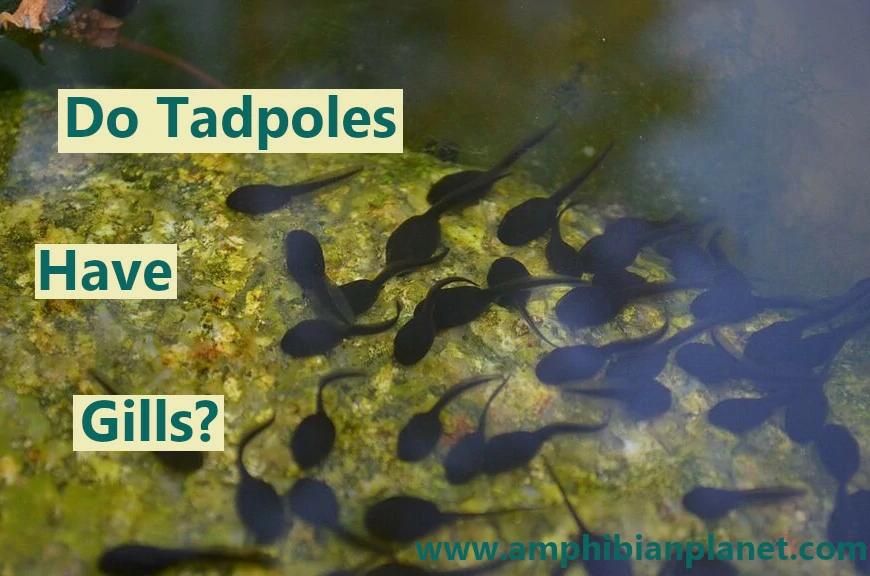Most frogs (not all), start their lives as tiny tadpoles adapted for a fully aquatic life. Over time, the tadpoles will grow legs, lose their tails, and metamorph into adult frogs.
Tadpoles have external gills when they hatch. At about 4 -6 weeks old, the gills are gradually covered by skin, forming an opercular chamber with internal gills vented by spiracles. When the tadpoles are about 12 – 14 weeks old and reach the froglet stage of their development, they lose their gills.
Once the gills are lost, the froglets will breathe using their lungs as well as through their skin and thin membranes in their mouth and throat.
That said, it’s important to note that many factors can affect tadpole development rate, including the species, temperature, and availability of food.
Early-Stage Tadpoles Have External Gills
Tadpoles are very different from adult frogs; this is because they’re adapted for a fully aquatic life, while adult frogs are adapted for a semi-aquatic, or mostly terrestrial life (depending on the species).
When first hatched, tadpoles have visible external gills, often in pairs, on either side of their heads. They use these gills to breathe in the water, just like fish.


The gills have thin membranes and a network of blood vessels. These membranes absorb dissolved oxygen from the water and move it into the bloodstream.
At the same time, carbon dioxide from the bloodstream passes out through the membranes, and into the water.
Tadpoles Midway in Their Development Have Internal Gills
When tadpoles are about 4 – 6 weeks old, opercular folds grow backward from the hyoid arch of each side covering the external gills and gill slits.
In this way, a gill cover known as an “operculum” is formed enclosing the external gills and gill slits – turning the external gills into internal gills. These internal gills are vented by ventrolateral openings, known as spiracles.

Depending on the species, there can be:
- Two spiracles on both sides of the body,
- A single spiracle on the underside near the vent, or
- A single spiracle on the left side of the body
Spiracles are tubular structures leading out of the opercular chamber. Tadpoles eject water through the nostrils and through the spiracles.
Most Tadpoles Develop Functional Lungs in Addition to Gills
It was previously believed that tadpoles lacked lungs throughout most of the larval period, relying on gills and cutaneous respiration for gas exchange until lungs and air breathing developed during metamorphosis in preparation for adult life.
However, with new scientific research, it is now widely known that the development of lungs in many tadpoles occurs well before metamorphosis.
A study of the tadpoles of five frog species representing three families found that they all began to breathe air and fill the lungs within 3 days of hatching.
Air-breathing is essential for survival in water with low oxygen levels – where their gills (and skin) cannot absorb sufficient oxygen.
Many tadpoles experience hypoxic waters for some if not most of their lives – a problem which is worsened by the presence of predators such as fish in open waters with more oxygen.
Air-breathing may also be necessary for normal lung development in some species.
How Tadpoles Breathe Air
When they first hatch, the tadpoles are too feeble to break through the water’s surface for a gulp of air. To get around this, they “bubble-suck”.

To do this, they first attach their open mouths to the underside of the water’s surface. They then open their jaws wide and suck at the water’s surface. Doing this creates an air pocket that they can pinch off by quickly closing their jaws.
After they close their mouth, a portion of the fresh air bubble is forced down into their lungs;
Since the tadpoles are tiny, they usually cannot absorb the entire air bubble, and the excess is burped out as a small bubble, after which it floats back up to the water’s surface.
Once the tadpoles get bigger, they will be strong enough to break through the water’s surface for a gulp of air (‘breach breathing’).
However, the tadpoles of some frog species such as the Gray tree frog (Hyla versicolor) continue to bubble-suck throughout the larval period and well into metamorphosis, despite growing large and fast enough to breach the surface.
When Do Tadpoles Lose Their Gills?
In general, tadpoles lose their gills as they transition into the froglet stage of their development. This is about 12 – 14 weeks after hatching in many frog species. While the gills are being broken down, the lungs develop rapidly into the main organ of respiration.
Tadpoles at the froglet stage of development look like tiny frogs with tails and will spend a lot of their time by the edge of the water, sometimes leaving the water.

Froglets cannot survive out of water for a long time, so they will return to their pond frequently at this stage.
Once metamorphosis fully is complete, the tadpoles will be young frogs and will leave the water to live on land. These young frogs will grow and mature into adults over time.
Adult Frogs Do Not Have Gills
Once the metamorphosis from tadpole to frog is complete – frogs do not have any gills. They breathe using their lungs as well as through their skin and thin membranes in their mouth and throat (cutaneous respiration).
That said, it’s important to note that amphibian lungs are quite primitive when compared to our own. They do not have diaphragms to push air into the lungs as we do. Instead, they rely on a process known as “buccal pumping.”
Buccal Pumping is basically a process of moving air in and out of the lungs through the use of the mouth and throat muscles.

To breathe in, the frog will lower the floor of its mouth, which causes the throat to expand. Air then rushes into the throat, through the mouth, and through the open nostrils.
The frog will then close its nostrils, and raise the floor of its mouth, which causes the throat to contract, and pushes the air into the lungs.
Once the air is in the lungs, oxygen from the air is then absorbed into the frogs’ bloodstream. At the same time, carbon dioxide from the bloodstream is diffused into the air.
To breathe out, the frog will lower the floor of its mouth, which causes the throat to expand and draws the air from the lungs, and into the mouth. It will then open its nostrils, and raise the floor of its mouth, to push the air out of the nostrils.
How Adult Frogs Breathe Through Their Skin
Lungs alone usually can not give a frog all the oxygen it needs. For this reason, frogs can also breathe through their skin and thin membranes in their mouth and throat to get extra oxygen, in a process known as cutaneous respiration.
The skin is made up of thin membranous tissue that is highly permeable to water and contains a large network of capillaries and other blood vessels close to the surface.
The thin membranous skin allows oxygen from the air to be absorbed into the bloodstream via diffusion. At the same time, carbon dioxide from the bloodstream passes through the skin and membranes and is diffused into the air.
To efficiently breathe, frogs have to keep their skin constantly moist by secreting a mucous coating. They can only absorb oxygen through their skin if the skin stays moist. If it dries up, they can suffocate and die.
In some frog species, cutaneous respiration is so efficient that it is their main way of breathing.
When adult frogs are underwater, they can not use their lungs to breathe air. For this reason, they breathe underwater entirely via cutaneous respiration. Dissolved oxygen in the water is absorbed through their skin and into the bloodstream via diffusion, and carbon dioxide is released from the bloodstream into the water
However, this method of breathing does not give them all the oxygen they need, so they can only be underwater for a limited time before they have to resurface to breathe with their lungs.
Sources:
Schwenk, K., Phillips, J. (2020). Circumventing Surface Tension: Tadpoles Suck Bubbles To Breathe Air. Proc. R. Soc. B., 1921(287), 20192704. https://doi.org/10.1098/rspb.2019.2704
Scott Pronych and Richard Wassersug. 2011. Lung use and development in Xenopus laevis tadpoles. Canadian Journal of Zoology. 72(4): 738-743. https://doi.org/10.1139/z94-099
Jackson R. Phillips, Amanda E. Hewes, Kurt Schwenk; The mechanics of air breathing in gray tree frog tadpoles, Hyla versicolor (Anura: Hylidae). J Exp Biol 1 March 2020; 223 (5): jeb219311. doi: https://doi.org/10.1242/jeb.219311
ScienceDirect. Tadpole. Accessed at: https://www.sciencedirect.com/topics/biochemistry-genetics-and-molecular-biology/tadpol


